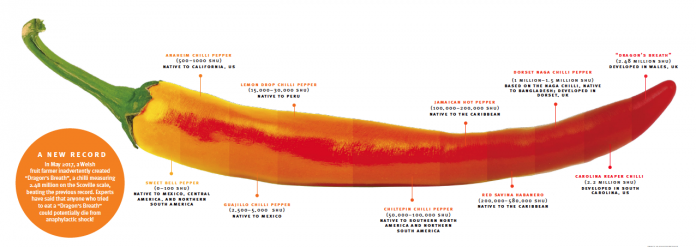The chilli pepper is an indispensable part of Asian cuisine. As anyone who has accidentally eaten a Bird’s Eye chilli will know, some varieties can blow your top off. But how hot is too hot?
Text Alex Campbell
In May 2017, a Welsh fruit farmer seta new record in the searing field of chillies when he inadvertently created “Dragon’s Breath”, a chilli measuring 2.48 million on the Scoville scale. Experts said that anyone who tried to eat a “Dragon’s Breath” could potentially die from anaphylactic shock!
The Scoville scale is the means of measuring how hot a chilli pepper is. It measures the concentration of capsaicin, the chemical compound that produces the heat sensation. The scale was invented by pharmacist Wilbur L. Scoville (1865–1942), and allocates a measurable unit of spiciness, called a Scoville heat unit (SHU). These ratings are determined by the Scoville organoleptic test. Capsaicin oil is extracted from the pepper, and is then incrementally diluted with sugar water. A panel of five (brave!) testers sample the concoction until they can no longer taste the spiciness.It’s not a fool-proof method, as each person has a different taste experience.
Asia’s contenders for hottest chilli:
1. Aleppo Pepper
At about 10,000 SHU, the Aleppo pepper, also referred to as the Halaby pepper, gets its name from the ancient city of Aleppo in Syria. It is also commonly grown in Turkey. It is usually dried and crushed.
2. Jwala Finger Hot chilli pepper
Measuring between 20,000 and 30,000 SHU, the Jwala is one of the most popular chillis in India, and is frequently added to Indian dishes for flavour – and spice.
3. Guntur Sannam chilli pepper
Clocking in at 35,000 to 40,000 SHU, the Guntur Sannam chilli is grown in and around Guntur in the state of Andhra Pradesh in India.
4. Santaka chilli pepper
From Japan, the Santaka chili pepper is a hot and flavourful Asian variety. At 40,000 to 50,000 SHU, it is commonly used in stir-fries.
5. Tien Tsin pepper
The Tien Tsin is named after the province in China where it was originally harvested. It measures in at between 50,000 and 75,000 SHU.
6. Bird’s Eye chilli
At between 50,000 and 100,000 SHU, the tiny bird’s eye chilli is commonly found in Cambodia, Vietnam, Thailand, and the Philippines – but it’s exported all over the world. It’s dynamite in a small package!
7. Thai chilli pepper
There is no single “Thai chilli pepper”, although most within this family of 79 vie for the title. They are all small and rather hot, at between 50,000 – 100,000 SHU.
8. Dundicut chilli pepper
At between 55,000 and 65,000 SHU, these tiny round
chilli peppers from Pakistan are similar in size and flavour to the spicy Scotch bonnet pepper, but they are of a different species, and are not quite as hot.
9. Yatsafusa chilli pepper
Also known as the Japanese chilli owing to their origins, this 75,000-Scoville chilli comes from a small plant with a yellow flower – but don’t let that fool you. They’re as hot as Hades!
10. Tabiche chilli pepper
Originally from India, the Tabiche pepper can now be found growing worldwide and often year-round, but it does best in hot, dry climates. 85,000 to 115,000 SHU.
11. Scotch bonnet
At 100,000 to 350,000 SHU, this pepper isamong the hottest peppers anywhere. It appears in the Carribean and in Guyana – and the Maldives.
12. Naga Jolokia (Ghost Chilli/Cobra Chilli)
This was once the hottest chilli pepper in the world, according to the Guinness Book of World Records. Its origins are in the Assam region of India and neighbouring Bangladesh. With a Scoville rating of over 1 million, it’s not for the faint-hearted!
Related Story: Asia’s Superfoods [Infographic]
Related Story: The World’s Wee Riches
Did you know: spicy foods are associated with health benefits?
- Adding extra spice can speed up weight loss! Hot peppers increase your body heat, which boosts metabolism.
- Peppers impact the body’s circulation, and can lower blood pressure; capsaicin may also help prevent blood clot.
- Capsaicin can block cancer cells! In one study, it killed 80 percent of cancer cells in mice.
- A recent study showed that people who ate spicy foods six or seven times a week had a 14 percent lower risk of dying prematurely. Eat hot, live longer!
- People suffering from arthritis, shingles, even some kinds of headaches can buy cream with capsaicin as the active ingredient to relieve pain.
For more stories from this issue, get your copy of Asian Geographic Issue 127, 2017.











